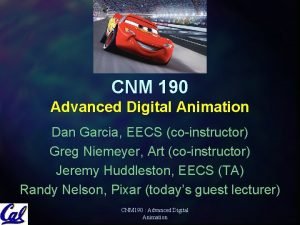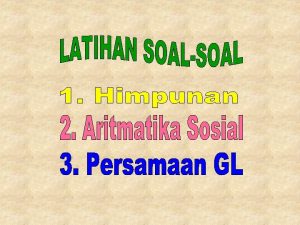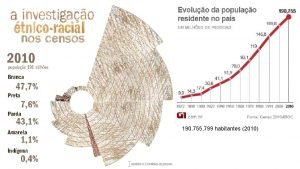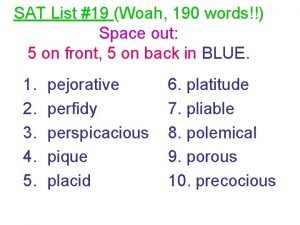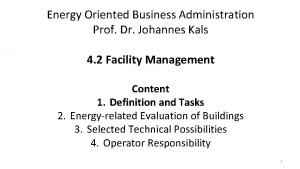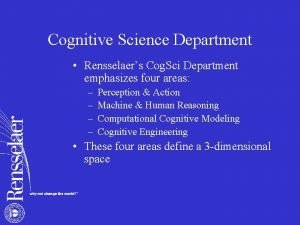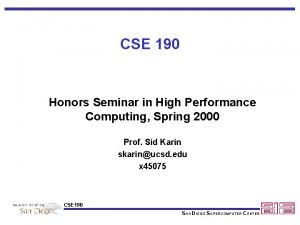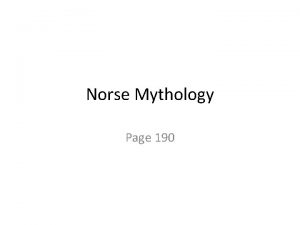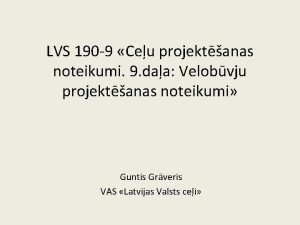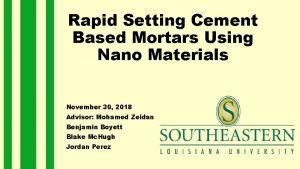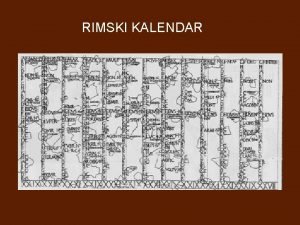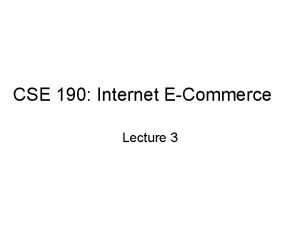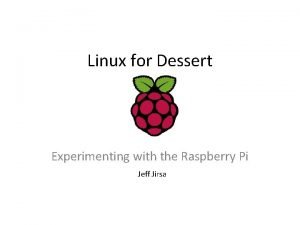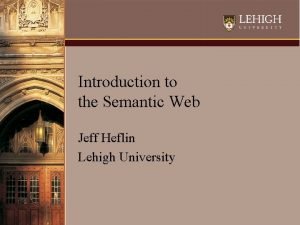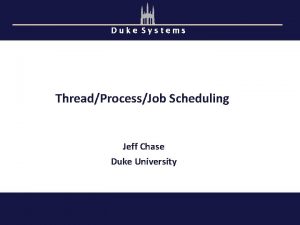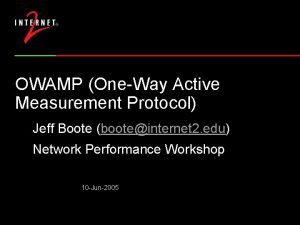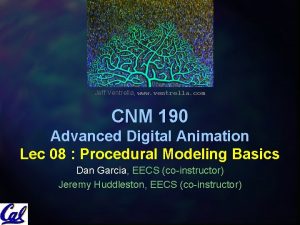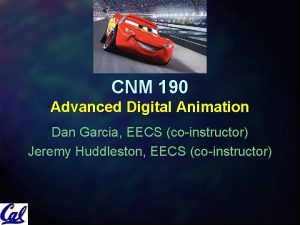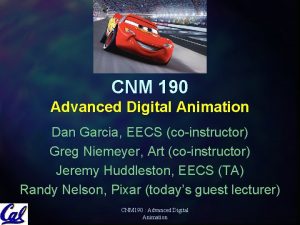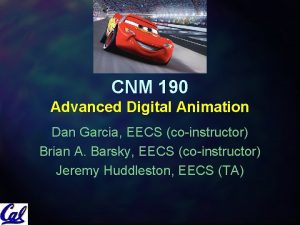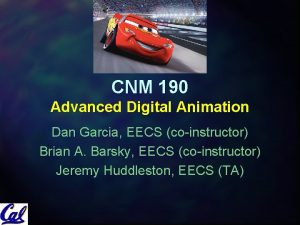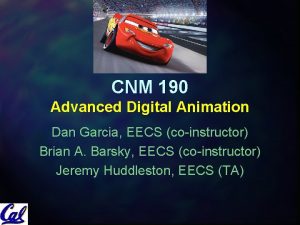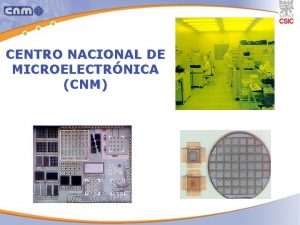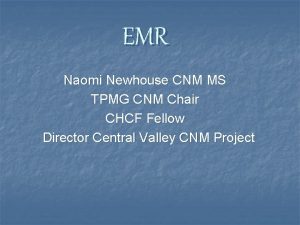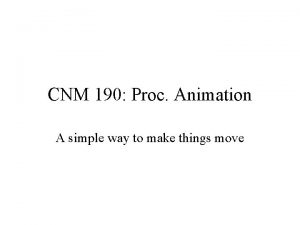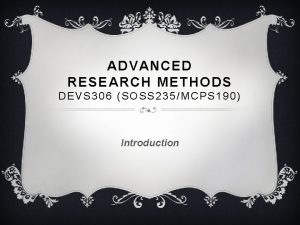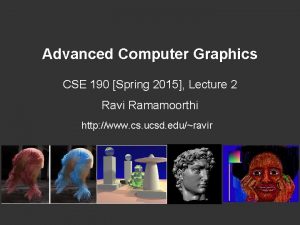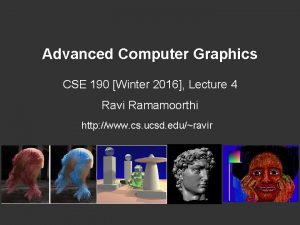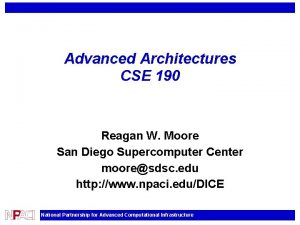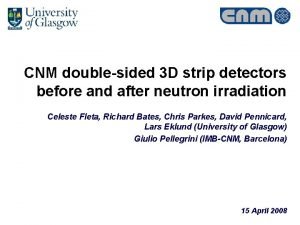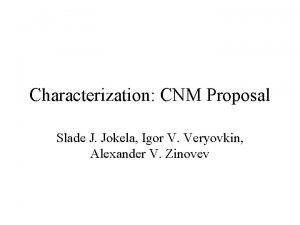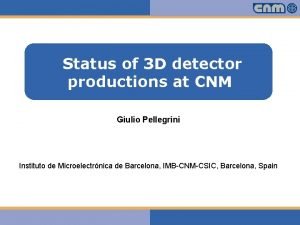CNM 190 Jeff Ventrella www ventrella com Advanced






























- Slides: 30

CNM 190 Jeff Ventrella, www. ventrella. com Advanced Digital Animation Lec 05 : Procedural Modeling Basics Dan Garcia, EECS (co-instructor) Greg Niemeyer, Art (co-instructor) Jeremy Huddleston, EECS (TA) Procedural Modeling Basics Carlo Séquin , EECS (guest lecturer)

Overview n Dan on Procedural Modeling Basics n n n Great references A note before starting What IS it? Why would you use it? What are its varied flavors? Control vs Chaos Randomness, Perlin Noise Fractals & L-systems Genetic algorithms How do we do it? Conclusion n Carlo on Procedural Modeling of Abstract Geometric Sculptures n Trying to find the underlying paradigm and suitable parameterization for a new class of shapes C 10 Hearst Field Annex; 642 -9920 CNM 19 Procedural Modeling Basics http: //inst. eecs. berkeley. edu/~selfpace/ 2

Great references n “Texturing & Modeling : A procedural approach” (2/e) n n n David S. Ebert, F. Kenton Musgrave, Darwyn Peachey Ken Perlin & Steven Worley Morgan Kaufman, 1998 “The Computational Beauty of Nature” n n Gary William Flake MIT Press, 2000 C 10 Hearst Field Annex; 642 -9920 CNM 19 Procedural Modeling Basics http: //inst. eecs. berkeley. edu/~selfpace/ 3

What IS it? en. wikipedia. org/wiki/Procedural_modeling n “Procedural modeling is an umbrella term for a number of techniques in computer graphics to create 3 D models (and textures) from sets of rules. L -Systems, fractals, and generative modeling are procedural modeling techniques since they apply algorithms for producing scenes. The set of rules may either be embedded into the algorithm, configurable by parameters, or the set of rules is separate from the evaluation engine. ” “Although all modeling techniques on a computer require algorithms to manage & store data at some point…” “procedural modeling focuses on creating a model from a rule set, Procedural rather than editing the model by CNM 19 Modeling Basics http: //inst. eecs. berkeley. edu/~selfpace/ mouse. ” C 10 Hearst Field Annex; 642 -9920 5

Why would you use it? en. wikipedia. org/wiki/Procedural_modeling n “Procedural Modeling is applied when it would be too cumbersome (or impossible!) to create a model using general 3 D modelers, or when more specialized tools are required. This is the case for plants & landscapes. ” Paul Martz, martz@frii. com garden of the metal C 10 Hearst Field Annex; 642 -9920 CNM 19 Procedural Modeling Basics http: //inst. eecs. berkeley. edu/~selfpace/ 6

What are its varied flavors? n Algorithm- or Data-driven geometry n …and animation (we’ll talk about later) n Fractals n Objects, landscapes, coastlines n Particle Systems n Simulations n Hair, fur, water, clouds, natural phenomena n Genetic Algorithms n More? C 10 Hearst Field Annex; 642 -9920 CNM 19 Procedural Modeling Basics http: //inst. eecs. berkeley. edu/~selfpace/ 7

Control vs Chaos n How much do you let randomness control your geometry? n n None at all means you’ll always get predictable results You can constrain randomness You can either randomize or set the initial seed, which can give repeatable randomness Or you can give in to chaos, setting initial conditions and letting it run Sometimes deterministic rules generates chaotic sequence… emergent C 10 randomness! Hearst Field Annex; 642 -9920 Control Chaos n CNM 19 Life 1 D Rule 30 Procedural Modeling Basics http: //inst. eecs. berkeley. edu/~selfpace/ 8

What is (pseudo) randomness? en. wikipedia. org/wiki/Random_number_generator Almost every programming language has a built in random() and seed() n They usually return a uniformly-distributed floating point number [0, 1). E. g. , in Python: n n n >>> from random import * >>> random() 0. 72936670465656062 E(x) 0 That’s pretty good for almost every CG use n n x 1 For other applications (e. g. , crypto), often use “natural randomness” from physical processes. See www. lavarnd. org C 10 Hearst Field Annex; 642 -9920 CNM 19 Procedural Modeling Basics http: //inst. eecs. berkeley. edu/~selfpace/ 9

What is the seed? n The seed()allows for repeatability! n n n n n >>> seed(0) # Arg => initialization >>> random() 0. 84442185152504812 >>> random() 0. 75795440294030247 >>> random() 0. 420571580830845 >>> seed(0) >>> random() 0. 84442185152504812 C 10 Hearst Field Annex; 642 -9920 CNM 19 Procedural Modeling Basics http: //inst. eecs. berkeley. edu/~selfpace/ 10

What is the seed’s argument? n Seeding allows for multiple repeatable paths! n n n >>> seed(0) >>> random() 0. 84442185152504812 >>> seed(1) >>> random() 0. 13436424411240122 C 10 Hearst Field Annex; 642 -9920 CNM 19 Procedural Modeling Basics http: //inst. eecs. berkeley. edu/~selfpace/ 11

How do we constrain it? n Scale the random variables down so its effect isn’t felt much, and range changes n n n >>> r = random() # [0, 1) >>> h = avg + 2*r*c - c # height What does the distribution of h look like? E(x) avg-c n avg+c x If we want our noise to vary between -1 and 1, as we often do, how would we do that? C 10 Hearst Field Annex; 642 -9920 CNM 19 Procedural Modeling Basics http: //inst. eecs. berkeley. edu/~selfpace/ 12

Perlin Noise Background mrl. nyu. edu/~perlin/doc/oscar. html n n n Ken Perlin, NYU Prof In 1983 he “invented” the idea of CG noise In 1985 he wrote the seminal SIGGRAPH paper (top 10 most influential in CG!) In 1986 it started being adopted by all! In 1997 he received an Oscar for his work C 10 Hearst Field Annex; 642 -9920 CNM 19 Procedural Modeling Basics http: //inst. eecs. berkeley. edu/~selfpace/ 13

Perlin Noise Basics I freespace. virgin. net/hugo. elias/models/m_perlin. htm n Idea… start w/noise from random() n Smoothly interpolate …We have a continuous function of F(t), yay! C 10 Hearst Field Annex; 642 -9920 n CNM 19 Procedural Modeling Basics http: //inst. eecs. berkeley. edu/~selfpace/ 14

Perlin Noise Basics II freespace. virgin. net/hugo. elias/models/m_perlin. htm n Amplitude and frequency n …which for a Noise wave n …is controllable via: AMP * F(FREQ * t) C 10 Hearst Field Annex; 642 -9920 CNM 19 Procedural Modeling Basics http: //inst. eecs. berkeley. edu/~selfpace/ 15

Perlin Noise Basics III freespace. virgin. net/hugo. elias/models/m_perlin. htm n Now, take combinations of these AMP and FREQ octaves and sum them together. + + n C 10 Hearst CNM 19 = + Note that here we double the FREQ and halve the AMP, so the high frequencies affect the result much less than the low Field Annex; 642 -9920 Perlin noise fractal 1 D mountain Procedural Modeling Basics http: //inst. eecs. berkeley. edu/~selfpace/ 16

Perlin Noise Basics IV freespace. virgin. net/hugo. elias/models/m_perlin. htm n This also works in 2 D + + = + + n + …and for 3 D, and for 4 D! Perlin noise fractal 2 D mountain (or texture!) genesis C 10 Hearst Field Annex; 642 -9920 CNM 19 Procedural Modeling Basics http: //inst. eecs. berkeley. edu/~selfpace/ 17

Perlin Noise Basics V freespace. virgin. net/hugo. elias/models/m_perlin. htm How should you attenuate the AMP as you’re increasing FREQ? How rocky will your mountain be? n Introduce Persistence n n n Frequency = 2 i Amplitude = persistencei C 10 Hearst Field Annex; 642 -9920 CNM 19 Procedural Modeling Basics http: //inst. eecs. berkeley. edu/~selfpace/ 18

Perlin Noise Details freespace. virgin. net/hugo. elias/models/m_perlin. htm n How many octaves? n n How to interpolate? n n Linear, cosine, cubic, many spline options Can smooth noise n n Up to you, not more than you can see Average with neighbors Center random @ [-1, 1] n You can turn noise up or down and it just “fuzzes out” to zero when the scale is small C 10 Hearst Field Annex; 642 -9920 CNM 19 Procedural Modeling Basics http: //inst. eecs. berkeley. edu/~selfpace/ 19

Perlin Noise Final Thoughts www. noisemachine. com/talk 1/ n Perlin summarizes history and context in an online talk (link shown above) n n “Making Noise”, 1999 He thinks of noise like salt n Noise [salt] n n F(blah) [food without salt] n n is boring can be boring F(noise, blah) n can be really tasty We’ll see this again in CNM 191 when we cover procedural textures (I. e. , shaders ) 642 -9920 C 10 Hearst Field Annex; n CNM 19 Procedural Modeling Basics http: //inst. eecs. berkeley. edu/~selfpace/ 20

Fractal Geometry Overview n A shape recursively constructed, or selfsimilar. How similar? n n Exact Quasi Statistical Fractals are also found in nature, so can be used to model n Clouds, snow flakes, mountains, rivers Sierpinski pyramids C 10 Hearst Field Annex; 642 -9920 CNM 19 Procedural Modeling Basics http: //inst. eecs. berkeley. edu/~selfpace/ 21

Fractal Geometry Simplicity en. wikipedia. org/wiki/Dragon_curve The beauty of them is also how little code is required to author! n Base case n n n Dragon curve Draw a straight line and choose an “up” Recursive case Break every line in 2, bend them to make a right angle, and set the “left” line up and the “right” line down. C 10 Hearst Field Annex; 642 -9920 n CNM 19 dragon, dan’s fractals, ucbugg 2 d Procedural Modeling Basics http: //inst. eecs. berkeley. edu/~selfpace/ 22

Fractal Geometry in 3 D en. wikipedia. org/wiki/Menger_sponge It’s just as simple in 3 D n Dan’s Menger cube: n n Base case (n=0) n n Spit out cube Recursive case (n) n Scale down the world by a third – I. e. , scale (1/3, 1/3) n Move to the rims of the cube, leaving middles empty (20 in total) – I. e. , Translate (blah) Call yourself recursively Annex; with 642 -9920 the n-1 case n C 10 Hearst Field CNM 19 hard*. tif, siercube, ucbugg 3 d Procedural Modeling Basics http: //inst. eecs. berkeley. edu/~selfpace/ 23

Lindenmayer system (Lsystem) en. wikipedia. org/wiki/L-system Formal grammar often used to model the growth of plant development n These can also be used to specify / generate fractals n Simply put, it’s a series of rewriting rules that can succinctly describe fractal geometry using turtle graphics n Weeds C 10 Hearst Field Annex; 642 -9920 CNM 19 Procedural Modeling Basics http: //inst. eecs. berkeley. edu/~selfpace/ 24

L-system example : C-Curve en. wikipedia. org/wiki/Dragon_curve Angle 90 degrees n Initial string FX n n n F means move forward, in Turtle graphics mode String rewriting rules n n n Dragon curve X X+YF+ Y -FX-Y Example n n n 1 : FX F 2 : FX+YF+ F+F+ 3 : FX+YF++-Fx-YF+ F+F+F-F C 10 Hearst Field Annex; 642 -9920 CNM 19 Procedural Modeling Basics http: //inst. eecs. berkeley. edu/~selfpace/ 25

Particle systems en. wikipedia. org/wiki/Particle_systems n Typically used to simulate fuzzy phonomena n Smoke, Explosions, Water, Sparks, Dust, Stars Emitter controls particle generation, simulation n What is involved with the geometry? n n Typically output as textured billboard quad Or, single pixel Or, metaball (for gooey materials) C 10 Hearst Field Annex; 642 -9920 CNM 19 Procedural Modeling Basics http: //inst. eecs. berkeley. edu/~selfpace/ pixar cosmic voyage 26

Genetic Algorithms web. genarts. com/karl/ n Karl Sims blew away his colleagues with his 1994 seminal work on evolved creatures evolved virtual creatures C 10 Hearst Field Annex; 642 -9920 CNM 19 Procedural Modeling Basics http: //inst. eecs. berkeley. edu/~selfpace/ 27

Genetic Algorithms web. genarts. com/karl/papers/siggraph 91. html Genotype is the genetic information that codes the creation of an individual n Phenotype is the individual n Selection is the process by which fitness of phenotypes is determined n Reproduction is the process by which new genotypes are generated from existing ones n There must be probabilistic mutations with some frequency C 10 Hearst Field Annex; 642 -9920 n CNM 19 Procedural Modeling Basics http: //inst. eecs. berkeley. edu/~selfpace/ panspermia 28

How do we do it in Renderman? renderman. pixar. com/products/whatsrenderman/ www. cs. berkeley. edu/~ddgarcia/renderman/ n n Easy! Renderman supports a library that you can compile with your C program that will help you output RIB is the intermediate file that Renderman reads The result of a render is a tiff file (or multiple tiffs) C 10 Hearst Field Annex; 642 -9920 CNM 19 Procedural Modeling Basics http: //inst. eecs. berkeley. edu/~selfpace/ 29

How do we do it in Maya? n n n Easy! Every action you perform in Maya is available in the Script Editor You can generate this text explicitly through a program using the techniques we just discussed. E. g. , Name it Foo. mel Or you can use MEL as a programming language (it looks like C) and do all your scripting there! Open this in Maya (double-click, or use the Script Editor) C 10 Hearst Field Annex; 642 -9920 CNM 19 Procedural Modeling Basics http: //inst. eecs. berkeley. edu/~selfpace/ 30

Conclusion n n There’s a wonderful world of procedural geometry waiting for you to discover! Let the mathematician in you run wild! Take a look at some of the wonderful sculptures by Prof Séquin on the 6 th floor for inspiration Speak of the artist!! Next week: n Hair, fur, sets + Pixar guest! C 10 Hearst Field Annex; 642 -9920 CNM 19 Procedural Modeling Basics http: //inst. eecs. berkeley. edu/~selfpace/ 31
 Cnm 190
Cnm 190 Nmcid
Nmcid Bài thơ mẹ đi làm từ sáng sớm
Bài thơ mẹ đi làm từ sáng sớm Cơm
Cơm Cnm dallas
Cnm dallas Lion poids 130 kg
Lion poids 130 kg S adalah bilangan
S adalah bilangan 190 755 799
190 755 799 190 words
190 words Gefma richtlinie 190
Gefma richtlinie 190 A 190 000 w engine can accelerate
A 190 000 w engine can accelerate Vertical
Vertical Da form 2823
Da form 2823 Cogsci 190
Cogsci 190 Telescience museum
Telescience museum Me 190 sjsu
Me 190 sjsu Norse blind god
Norse blind god Mk noteikumi 190
Mk noteikumi 190 Adva 190
Adva 190 Rimski kalendar
Rimski kalendar Cse 190
Cse 190 190 vauxhall bridge road mental health
190 vauxhall bridge road mental health Jeff jirsa
Jeff jirsa Jeff heflin
Jeff heflin Jeff brown math
Jeff brown math Jeff bezos prime video prime
Jeff bezos prime video prime Jeff chase duke
Jeff chase duke Jeff reiter
Jeff reiter Jeff jasper
Jeff jasper Jeff boote
Jeff boote Jeff sher
Jeff sher
